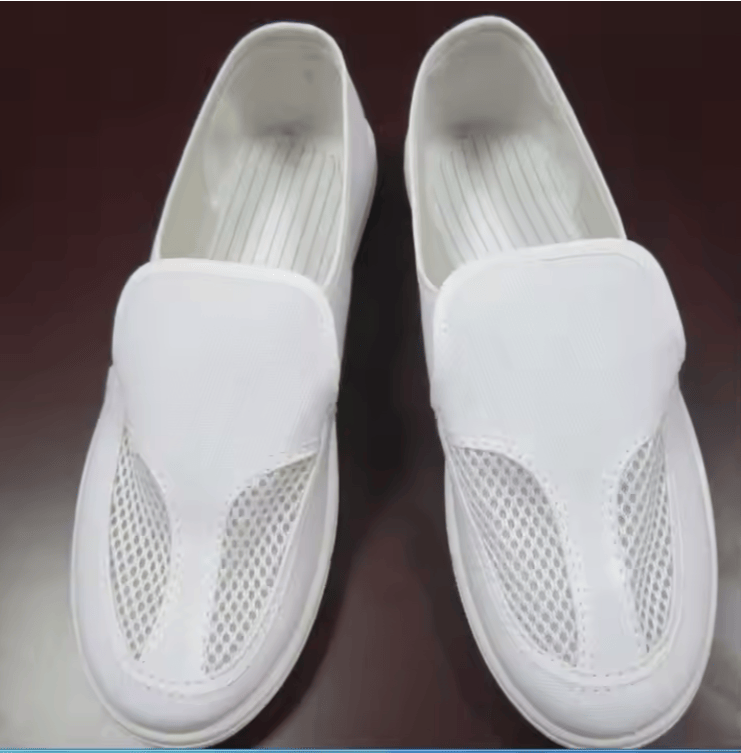What Are ESD Shoes?

Definition:
ESD Shoes, or Electrostatic Discharge Shoes, are specialized footwear designed to prevent the buildup of static electricity in the human body and safely discharge it to the ground. These shoes protect sensitive electronic components from static discharge that could occur during handling.
They are essential components of ESD control programs in electronics manufacturing, cleanrooms, and explosive environments.
How Do ESD Shoes Work?
The human body naturally builds up electrostatic charges through movement, especially in environments with synthetic materials. ESD shoes are made from conductive or dissipative materials that create a low-resistance path from the body through the shoe sole to an ESD-safe floor, neutralizing the charge.
Working Mechanism:
The shoe sole is made of conductive rubber or PU with a resistance range typically between 1 × 10⁵ Ω and 1 × 10⁹ Ω.
A conductive insole and ESD sock or contact strip ensure the static from the body flows through the shoe.
The charge flows to conductive flooring and is safely discharged to ground.
Key Features of ESD Shoes
| Feature | Description |
|---|---|
| Resistance Range | Typically between 10⁵ and 10⁹ ohms |
| Materials | Conductive rubber, PU, EVA, carbon-blended fibers |
| Toe Options | With or without steel/composite toe |
| Slip Resistance | Designed for lab or cleanroom floors |
| Comfort | Cushioned for long hours of standing |
| Certifications | ANSI/ESD STM9.1, IEC 61340-4-3, ASTM F150 |
Types of ESD Shoes
ESD Work Shoes (Formal/Closed Style)
Used in electronics assembly, aerospace, or medical manufacturing
Can look like sneakers, loafers, or Oxfords
ESD Safety Shoes (Steel Toe / Composite Toe)
Combine static control with impact protection
Ideal for factory, warehouse, and logistics
ESD Slippers / Sandals
Often used in cleanroom environments
Lightweight and breathable
ESD Boot Covers or Overshoes
Used in ultra-clean environments over regular footwear
Applications of ESD Shoes
| Industry | Purpose |
|---|---|
| Electronics Manufacturing | Prevents static damage to microchips and PCBs |
| Semiconductor Fabrication | Critical in cleanroom static control |
| Aerospace & Defense | Ensures system reliability during assembly |
| Automotive Electronics | Protects ECUs and embedded systems |
| Pharmaceutical | ESD & contamination control in clean areas |
| Explosive/Flammable Environments | Prevents ignition from static sparks |
How to Choose the Right ESD Shoes
Check Compliance
Meets standards: IEC 61340-5-1, ANSI/ESD STM9.1
Determine Resistance Needs
Choose based on your ESD floor system (dissipative vs. conductive)
Type of Work
Safety toe for mechanical work, breathable styles for cleanrooms
Fit and Comfort
Good arch support and cushioning for long shifts
Environment
Waterproof or breathable options depending on location
Maintenance
Clean regularly; check for sole wear — worn soles can lose ESD effectiveness
Difference: ESD Shoes vs. Antistatic Shoes
| Feature | ESD Shoes | Antistatic Shoes |
|---|---|---|
| Resistance | 10⁵ to 10⁹ Ω | 10⁶ to 10⁹ Ω |
| Discharge Capability | Discharge to ground to protect electronics | Discharge to ground to protect people (e.g., flammable areas) |
| Standards | ANSI/ESD, IEC 61340 | EN ISO 20345 (SB/A/E) |
| Applications | Electronics, cleanrooms | Explosive environments, general industry |
Testing & Certification
ESD Shoes are typically tested for:
Electrical resistance
Surface resistance (floor and footwear together)
Continuity from insole to outsole
Testing methods:
IEC 61340-4-3
ANSI/ESD STM9.1
ASTM F150
Summary
| Key Point | Explanation |
|---|---|
| Definition | Shoes that dissipate static electricity to ground |
| Function | Protect sensitive electronics from ESD damage |
| Construction | Conductive soles, ESD-safe insoles, optional safety toes |
| Use Cases | Electronics, cleanrooms, aerospace, automotive |
| Certifications | ANSI/ESD, IEC 61340 standards |
